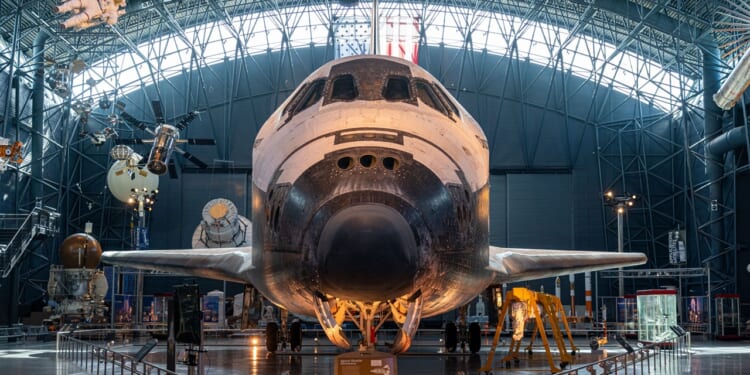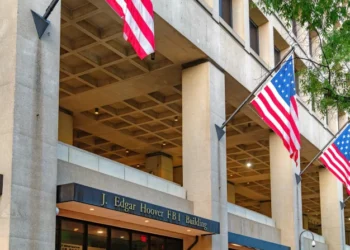Texas lawmakers have demanded the Discovery shuttle be moved to the Johnson Space Center in Houston, but daunting technical challenges remain—and Virginia officials have dug in against the move.
The Space Shuttle Discovery (OV-103), the third operational orbiter and the most-flown Space Shuttle, is now on display at the National Air and Space Museum’s Udvar-Hazy Center in northern Virginia.
However, Texas lawmakers have argued that the spacecraft should never have been offered to the Smithsonian—and have called for OV-103 to be moved to the Johnson Space Center (JSC) in Houston.
This past July, Texas senators John Cornyn and Ted Cruz introduced the “Bring the Space Shuttle Home Act,” which called for allocating $85 million to relocate the Space Shuttle to the Lone Star State. Space Center Houston already houses a shuttle replica on a 747 carrier aircraft.
Lawmakers and others in Texas have long argued that Discovery rightfully belongs at the JSC, where Mission Control led all Space Shuttle flights. Moreover, it argued that the astronauts who flew on shuttle missions lived and trained in Houston.
How Did the Discovery Shuttle End Up at the Smithsonian?
When the US space shuttle program ended in 2011, the four surviving orbiters found themselves in high demand back on Earth—with more than 20 organizations across the United States competing to obtain one. Ultimately, the Space Shuttle Atlantis (OV-104) wound up at the Kennedy Space Center Visitor Complex in Merritt Island, Florida, while the Space Shuttle Endeavor (OV-105) found a home at the California Science Center in Los Angeles. The Space Shuttle Enterprise (OV-101), which never flew in orbit but served as a test platform, had previously been on display at the Udvar-Hazy Center from 2003 to 2011, but was relocated to the USS Intrepid Museum in New York City, with the Smithsonian receiving the Discovery.
There have been questions as to why New York City received OV-101, as it had no significant connection to the program. The simple answer is that it may have had a larger tourist draw than JSC, with the former Essex-class aircraft carrier on the Hudson River just a few blocks from Times Square.
Texas Wants the Discovery Shuttle. Virginia Isn’t Budging.
The Texas lawmakers have made it very clear that they want Discovery returned to the Lone Star State. That desire is understandable, given Texas’ longtime connection to America’s space program and the JSC’s role as the headquarters of NASA’s mission control. However, the Smithsonian Institution has dug in, calling the move “unprecedented.” It also warned earlier this year that moving the shuttle could cause severe damage to its structure.
Experts have warned that the Discovery can’t really be moved without being dismantled. It is worth recalling that the shuttle was transported to Washington Dulles International Airport (IAD) in April 2012 on the back of a heavily modified Boeing 747, like the one now on display at JSC. It was then carefully moved from IAD to the adjacent Udvar-Hazy Center.
Unless Mission Control is willing to put that 747 back into service, there are no options to fly the shuttle from Virginia to Texas. With none of the original Boeing 747 Shuttle Carrier Aircraft (SCA) formerly used by NASA remaining in operation, the only other option to move the space shuttle would be via barge. The Smithsonian has warned that any attempt to move the shuttle would require some disassembly during this process.
The independent group KeeptheShuttle.org, which advocates for the shuttle to remain in Virginia, issued its own findings, which said it would “require a 25+ mile tow through Fairfax County and other parts of Northern Virginia to reach a navigable portion of the Potomac River, at which point the shuttle would be loaded onto a barge for a 2,000+ mile journey to Texas.”
Even though the recent “One Big Beautiful Bill Act” earmarked $85 million for transportation and eventual exhibition of the shuttle, the Smithsonian, with insight from NASA, determined the “actual costs” would be somewhere between $120 and $150 million, with that figure “exclusive of the cost” of any new exhibit at JSC.
This week, Cornyn and Cruz, joined by Texas Rep. Randy Weber of the 14th district, fired back at the Smithsonian’s claims and accused the institution of “illegal lobbying” against moving Discovery. They have called for the Department of Justice (DoJ) to conduct an “investigation into potential violations of the Anti-Lobbying Act.”
In the letter to the DoJ, the lawmakers wrote, “The Institution has circulated cost estimates that exceed quotes from experienced private-sector logistics firms by more than tenfold and has falsely claimed the shuttle’s wings would need to be removed for transport, a claim not supported by industry experts. These activities raise significant concerns under the Anti-Lobbying Act, which prohibits the use of appropriated funds for communications intended to influence members of the public to pressure Congress regarding legislation or appropriations matters.”
Could the Discovery Be Repaired If Dismantled?
Even as the battle over cost continues, the bigger debate is whether the shuttle would need to be partially dismantled, something that it was not designed for.
Each orbital vehicle was designed to be covered with thousands of extremely delicate ceramic tiles, developed to withstand the heat of re-entry into Earth’s atmosphere. Under those tiles are cables and connectors that cannot simply be unplugged or disconnected.
Joe Stief, organizer for KeepTheShuttle.org, warned this week that even breaking the shuttle down into its most significant components — wings, payload bay, and cockpit — would cause catastrophic damage to its structure. In addition to removing the tiles, miles of wires and cables would likely need to be cut.
Since the Discovery shuttle is never going back to space, some might argue that the cost of doing so would be minimal. Yet the Discovery is currently the most intact shuttle left over from the program, and has been preserved for future study.
In an email to The National Interest, Stief called the letter to the DoJ “a silly attempt to silence the Smithsonian from publicly defending their full and permanent ‘right, title and interest’ of Discovery, and a tactic that was previously tried with an appeal to Smithsonian Chancellor and Chief Justice of the Supreme Court John Roberts. While the Chancellor did not publicly take any actions after the August statement, it appears that Sen. Cornyn is hoping to find a more receptive audience at the Department of Justice.”
Stief added that Texas lawmakers aren’t focused enough on the potential damage that could result from moving the shuttle.
“I am not surprised that the relocation’s proponents were dismayed to see these facts presented to Congress and then publicly, but rather than providing any details of an alternative plan to relocate Discovery, they continue to allude to ‘industry experts’ who disagree with NASA and the Smithsonian—the organizations who designed, flew, transported and now preserve the shuttle.”
About the Author: Peter Suciu
Peter Suciu has contributed over 3,200 published pieces to more than four dozen magazines and websites over a 30-year career in journalism. He regularly writes about military hardware, firearms history, cybersecurity, politics, and international affairs. Peter is also a contributing writer for Forbes and Clearance Jobs. He is based in Michigan. You can follow him on Twitter: @PeterSuciu. You can email the author: [email protected].
Image: Shutterstock / Wirestock Creators.


















